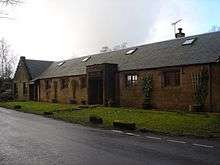Tullibardine
Tullibardine is a location in Perth and Kinross, Scotland, which gives its name to a village, a castle, and a grant of nobility.

The village of Tullibardine (56°18′25.5″N 3°44′23.5″W / 56.307083°N 3.739861°WCoordinates: 56°18′25.5″N 3°44′23.5″W / 56.307083°N 3.739861°W) is a settlement of some 40 dwellings 10 miles southwest of Perth. It lies in the parish of Blackford, though the nearest town is Auchterarder one and a half miles to the south.
Tullibardine Castle (56°18′18″N 3°45′49″W / 56.305079°N 3.763489°W) was a medieval fortification on a low eminence west of the village. Little is known about it and it no longer exists. The castle was built by the clan Murray in the late 13th to early 14th century, after they had extended their holdings south from their heartland in Morayshire. The castle predates the nearby chapel, which can be dated to 1446. The castle was dismantled in 1747, following the Jacobite rebellion, and was completely demolished in 1833.[1]

Tullibardine Chapel (56°18′04″N 3°45′49″W / 56.301030°N 3.763490°W) was built in the 1446 by David Murray of Tullibardine as a family chapel and burial site, and members of the Murray family were buried there until 1900. The chapel has remained unaltered since the 16th century.[2]
The Murray lords of Tullibardine were promoted to an earldom in the peerage of Scotland in 1606, and to a marquessate in 1696. A branch of the family became earls, then dukes of Atholl, and the title "Marquess of Tullibardine" remains the title of the Atholl heir. The most famous Lords of Tullibardine were William Murray, a leading figure of the 1715 and 1719 Jacobite rebellions, and his brother George, a leader in 1745.
In modern times Tullibardine was served by a station on the Crieff Junction Railway, later part of the Caledonian and then the London, Midland and Scottish railways. The station, which opened in 1856 was closed in 1964.
The name is now used by the Tullibardine distillery in nearby Blackford, which opened in 1949, and to several of their brands of whisky.
References
- ↑ Tullibardine Castle at stravalging.com; retrieved 10 May 2017
- ↑ Tullibardine Chapel at historicenvironment.scotland; retrieved 10 May 2017